Jason Schneider
the Camera Collector
The Last New DSLR Ever? It’s Probably the Pentax KF!
Unveiled in ‘22 this upgraded Pentax K-70 may be the last of the breed
By Jason Schneider
The year 2022 marked the decisive moment at which the Mirrorless camera or EVC (electronic viewfinder camera) totally eclipsed the once mighty DSLR as the dominant category among interchangeable lens digital cameras. Indeed, the Pentax KF, was the only new DSLR introduced in 2022, an attractive, modestly upgraded replacement for the popular APS-C-format Pentax K-70. The K-mount Pentax KF added a higher-res 1.04m-Dot articulated LCD and slightly revised internals that reduced its body weight by a teensy 0.1 ounces. But how ever meager its improvements, the sleek, stylish enthusiast-aimed Pentax KF may earn its place in history as the last new DSLR in the world.
The rise and ultimate victory of the mirrorless EVC was made possible by perfecting its signature feature, the electronic viewfinder (EVF). The OLED EVFs in the current crop of mirrorless EVCs deliver a viewing experience that equals, and in many ways surpasses, the optical viewfinders (OVFs) in the best DSLRs—a brilliant ultra-hi-res image in impressively vibrant and accurate color and presented at a high enough refresh rate to ensure a seamless viewing experience equal to the best OVFs. These EVFs also provide superior performance in low light by upping the gain, giving a brighter, clearer view of the subject. Also trending among mirrorless EVCs, are larger eyepieces with higher-magnification OLED EVFs to enhance viewing and composition.
Mirrorless EVCs have numerous other advantages both operational and physical. By eliminating the large and costly pentaprism and mirror box assembly, they can be made smaller and lighter than comparable DSLRs and have inherently greater flexibility in terms of form factor, resulting in many compact, elegant designs with more ergonomic controls. And of course, by eliminating the flipping mirror, a major source of camera-induced shake, they let you capture sharper images, with or without image stabilization, when shooting handheld at slower shutter speeds. Not surprisingly the current crop of mirrorless EVCs benefits from state-of-the-art technology that delivers impressive dynamic ranges, upgraded image stabilization specs, remarkable maximum full-res framing rates, vastly expanded ISO ranges, ultra-hi-res EVFs and LCDs, pro-caliber video parameters, and a host of other advanced AI-based features. However rather than extol the advantages of the triumphant EVCs, let’s do a quick rundown on the evolution of the DSLR, the camera type that laid the groundwork and provided the basis for today’s most advanced interchangeable lens digital cameras.
The World’s first DSLR: The Electro-Optic Camera
This tethered 1-megapixel beauty was designed and constructed by Eastman Kodak Co. under a U.S. Government contract in 1987 and 1988 and was inspired by Kodak’s Microtechnology Division (MTD) having announced the development of the first megapixel CCD in 1986. In 1987 a government customer asked Kodak’s Federal Systems Division (FSD) to build a new camera based on the new CCD. According to the lead engineer Jim McGarvey it was a “true skunk works project, with a very small team led by Ken Cupery the project manager, assisted by MTD engineer Bill Toohey, who designed the CCD analog circuitry, and technician Tom McCarthy, who assembled the whole system.” Mc Garvey continues, “…the customer preferred Canon film cameras, so I chose the beautiful and rugged New F-1 body, modifying the original door to attach the new CCD back, which was milled out of a solid aluminum block, with 3 small Allen screws used to adjust the focal plane of the CCD.
Three external LEDs to the left of the finder eyepiece indicate the status of the digital system.”
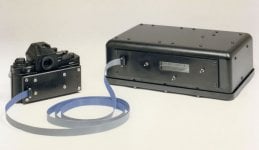
The first DSLR, the Elecrto-Optic Camera by Eastman Kodak Co. was tethered. Camera body is based on the Canon F-1.
Since the camera was intended for unobtrusive use, the CCD was mounted in a small addition to the back of a standard 35mm camera body, and the rest of the system was stuffed into a box connected to the camera with a thin ribbon cable, all of which fit into a normal shoulder bag. The Electro-Optic Camera project led to the Hawkeye II marketed to government customers, and in 1991 to the first commercial DSLRs, the Kodak DCS cameras by Kodak Professional Digital Camera System. This culminated in the Nikon D1 of 1999, the first professional DSLR to successfully challenge Kodak’s then-total dominance of the DSLR market.
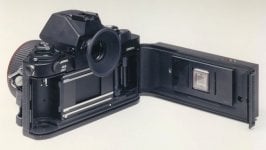
Open back of Kodak's groundbreaking SLR shows standard Canon F-1 body with CCD sensor in handmade digital back.
Over the next decade from 2000 to 2010, the DSLR category vastly expanded, and the DSLR quickly became the undisputed leader of the crucial pro and serious enthusiast consumer demographics. Manufacturers then entering the new, fiercely competitive DSLR market include Canon, Minolta (later Konica Minolta) Fujifilm, Sony, Pentax, Olympus, Sigma, and Kodak, all of which brought forth a profusion of broad spectrum and high-end pro/enthusiast models.
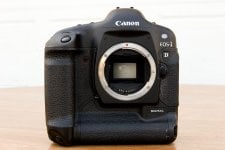
Canon EOS-1D: Canon's first top-of-the-line pro DSLR
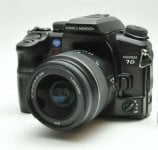
Konica Minolta Maxxum 7D was the first with in-body image stabilization, a feature widely adopted by other camera makers.
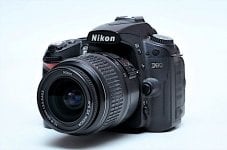
Nikon D90: The first DSLR with video capability, it was a trendsetter and virtually all DSLR that came after it could shoot video with sound.
During the 2010s, the major camera manufacturers began transitioning their product lines away from DSLRs to mirrorless EVC cameras. In September 2013, Olympus announced they would stop developing DSLRs to concentrate on mirrorless EVCs. In 2020 Nikon announced that they were terminating DSLR production in Japan, followed by similar announcements by Canon and Sony.
The Nikon D6: the last flagship DSLR
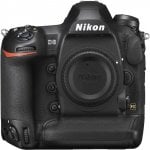
The mighty Nikon D6 of 2020, most likely the last top-of-the line pro DSLR.
However, in 2020 Nikon announced a final gift to DSLR fans, its last top-of-the-line, pro-aimed DSLR, the glorious Nikon D6. Featuring a full frame 20.8MP CMOS sensor mated to a high-spec EXPEED 6 Image Processor, this rugged beauty provides a full-res burst rate of 14 fps, sensitivity settings from ISO 100-102,000, extendable to an amazing ISO 3,280,000, a Multi-CAM 37 K 105-zone All Cross-Type AF system that provides 17 customizable Group Area AF patterns, and UHD 4K video recording at 30, 25, and 24 fps. All this and much more is built into a robust body with a magnesium alloy chassis and comprehensive dust and moisture sealing to allow working under harsh conditions. Measuring 6.3 x 6.42 x 3.62 inches (W x H x D) and weighing in at a hefty 2,79 pounds (body only) the Nikon D6 is certainly an impressive finale to one of the great line of pro DSLRs going back to 1999, but understandably it’s premium priced at a cool $6,496.95 body only.
The Pentax KF: The Last new DSLR Ever?
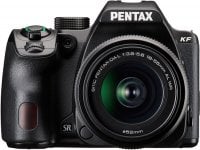
The Pentax KF, front view, with SMC PENTAX-DAL 18-55mm f/3.5-5.6 AL WR. Lens and body are both water resistant.
While one well respected reviewer dismisses the Pentax KF as “…simply the Pentax K-70 APS-C-format DSLR with a few very minor tweaks, mostly made as a result of changes in component availability” the KF, which replaces the K-70 in Ricoh’s Pentax line, is nevertheless a, sleek, elegant high-performance camera that will surely meet or exceed the expectations of the serious enthusiasts that comprise its target audience. Its 24.24MP CMOS sensor is coupled to a PRIME MII high speed imaging engine, a combo enabling res burst rates up to 6 fps, ISO settings of 100-102400, and full HD 1080i video at 60 fps. Its 3.0-inch Vari-Angle LCD monitor has had its res bumped up to 1.03m-dots for clearer viewing, and its built-in sensor-shift Shake Reduction system uses a gyro sensor to provide a 4.5-stop anti-shake advantage in handheld shooting, and its SAFOX AF system pricvides 11 phase-detection points including 9mcross-type sensors and operated down to -3 EV for low light work. Other features: 3 new custom image modes, Satobi, Bleach Bypass, and Cross Processing plus special Kyushu and Katen modes accessible with specific lenses, a Pixel Shift Resolution System that captures 4 images, each shifted by one pixel, and combines them into a single more detailed, higher resolution image,, comprehensive wireless, functionality, and dustproof, weatherproof construction using 100 seals throughout the body that also deliver outstanding cold-proof performance down to -14°F.
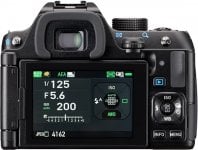
Back view of Pentax KF shows ergonomic control layout, articulated higher-res LCD with readouts, in storage position against body.
Bottom line: While the Pentax KF, the camera most likely to be the very last new DSLR brought to market is not a splendiferous flagship camera like the Nikon D6 of 2020, the decades-long saga of the DSLR has not ended with a whimper because the Pentax KF is beautiful camera and worthy contender in the broad-spectrum enthusiast class, and at $846.95 (body only) it’s also an outstanding value.
Canon EOS-1D, Canon's first top-of-the line pro DSLR.
Unveiled in ‘22 this upgraded Pentax K-70 may be the last of the breed
By Jason Schneider
The year 2022 marked the decisive moment at which the Mirrorless camera or EVC (electronic viewfinder camera) totally eclipsed the once mighty DSLR as the dominant category among interchangeable lens digital cameras. Indeed, the Pentax KF, was the only new DSLR introduced in 2022, an attractive, modestly upgraded replacement for the popular APS-C-format Pentax K-70. The K-mount Pentax KF added a higher-res 1.04m-Dot articulated LCD and slightly revised internals that reduced its body weight by a teensy 0.1 ounces. But how ever meager its improvements, the sleek, stylish enthusiast-aimed Pentax KF may earn its place in history as the last new DSLR in the world.
The rise and ultimate victory of the mirrorless EVC was made possible by perfecting its signature feature, the electronic viewfinder (EVF). The OLED EVFs in the current crop of mirrorless EVCs deliver a viewing experience that equals, and in many ways surpasses, the optical viewfinders (OVFs) in the best DSLRs—a brilliant ultra-hi-res image in impressively vibrant and accurate color and presented at a high enough refresh rate to ensure a seamless viewing experience equal to the best OVFs. These EVFs also provide superior performance in low light by upping the gain, giving a brighter, clearer view of the subject. Also trending among mirrorless EVCs, are larger eyepieces with higher-magnification OLED EVFs to enhance viewing and composition.
Mirrorless EVCs have numerous other advantages both operational and physical. By eliminating the large and costly pentaprism and mirror box assembly, they can be made smaller and lighter than comparable DSLRs and have inherently greater flexibility in terms of form factor, resulting in many compact, elegant designs with more ergonomic controls. And of course, by eliminating the flipping mirror, a major source of camera-induced shake, they let you capture sharper images, with or without image stabilization, when shooting handheld at slower shutter speeds. Not surprisingly the current crop of mirrorless EVCs benefits from state-of-the-art technology that delivers impressive dynamic ranges, upgraded image stabilization specs, remarkable maximum full-res framing rates, vastly expanded ISO ranges, ultra-hi-res EVFs and LCDs, pro-caliber video parameters, and a host of other advanced AI-based features. However rather than extol the advantages of the triumphant EVCs, let’s do a quick rundown on the evolution of the DSLR, the camera type that laid the groundwork and provided the basis for today’s most advanced interchangeable lens digital cameras.
The World’s first DSLR: The Electro-Optic Camera
This tethered 1-megapixel beauty was designed and constructed by Eastman Kodak Co. under a U.S. Government contract in 1987 and 1988 and was inspired by Kodak’s Microtechnology Division (MTD) having announced the development of the first megapixel CCD in 1986. In 1987 a government customer asked Kodak’s Federal Systems Division (FSD) to build a new camera based on the new CCD. According to the lead engineer Jim McGarvey it was a “true skunk works project, with a very small team led by Ken Cupery the project manager, assisted by MTD engineer Bill Toohey, who designed the CCD analog circuitry, and technician Tom McCarthy, who assembled the whole system.” Mc Garvey continues, “…the customer preferred Canon film cameras, so I chose the beautiful and rugged New F-1 body, modifying the original door to attach the new CCD back, which was milled out of a solid aluminum block, with 3 small Allen screws used to adjust the focal plane of the CCD.
Three external LEDs to the left of the finder eyepiece indicate the status of the digital system.”

The first DSLR, the Elecrto-Optic Camera by Eastman Kodak Co. was tethered. Camera body is based on the Canon F-1.
Since the camera was intended for unobtrusive use, the CCD was mounted in a small addition to the back of a standard 35mm camera body, and the rest of the system was stuffed into a box connected to the camera with a thin ribbon cable, all of which fit into a normal shoulder bag. The Electro-Optic Camera project led to the Hawkeye II marketed to government customers, and in 1991 to the first commercial DSLRs, the Kodak DCS cameras by Kodak Professional Digital Camera System. This culminated in the Nikon D1 of 1999, the first professional DSLR to successfully challenge Kodak’s then-total dominance of the DSLR market.

Open back of Kodak's groundbreaking SLR shows standard Canon F-1 body with CCD sensor in handmade digital back.
Over the next decade from 2000 to 2010, the DSLR category vastly expanded, and the DSLR quickly became the undisputed leader of the crucial pro and serious enthusiast consumer demographics. Manufacturers then entering the new, fiercely competitive DSLR market include Canon, Minolta (later Konica Minolta) Fujifilm, Sony, Pentax, Olympus, Sigma, and Kodak, all of which brought forth a profusion of broad spectrum and high-end pro/enthusiast models.
- In January 2000, Fujifilm announced the FinePix S, its first consumer-level DSLR.
- In November 2001 Canon released its first pro-caliber DSLR, the 4.1MP EOS-1D, and in 2003, unveiled the 6.3 MP EOS 300D (aha the Digital Rebel), the first DSLR with an MSRP under $1,000 ($999.00 to be exact).

Canon EOS-1D: Canon's first top-of-the-line pro DSLR
- In 2002 Nikon announced the very successful Nikon D100, offering pro-caliber performance at a reasonable price, using a 6.3MP APS-C-format CCD sensor. It inspired other manufacturers and was instrumental in expanding and refining the emerging DSLR mass market
- In 2004 Konica Minolta released the Konica Minolta Maxxum 7D, the first DSLR with in-body image stabilization, a feature soon adopted by Pentax, Olympus, and Sony.

Konica Minolta Maxxum 7D was the first with in-body image stabilization, a feature widely adopted by other camera makers.
- In early 2008 Nikon brought forth the D90, the first DSLR to feature video recording, a feature that soon became universal on all subsequent DSLRs.

Nikon D90: The first DSLR with video capability, it was a trendsetter and virtually all DSLR that came after it could shoot video with sound.
During the 2010s, the major camera manufacturers began transitioning their product lines away from DSLRs to mirrorless EVC cameras. In September 2013, Olympus announced they would stop developing DSLRs to concentrate on mirrorless EVCs. In 2020 Nikon announced that they were terminating DSLR production in Japan, followed by similar announcements by Canon and Sony.
The Nikon D6: the last flagship DSLR

The mighty Nikon D6 of 2020, most likely the last top-of-the line pro DSLR.
However, in 2020 Nikon announced a final gift to DSLR fans, its last top-of-the-line, pro-aimed DSLR, the glorious Nikon D6. Featuring a full frame 20.8MP CMOS sensor mated to a high-spec EXPEED 6 Image Processor, this rugged beauty provides a full-res burst rate of 14 fps, sensitivity settings from ISO 100-102,000, extendable to an amazing ISO 3,280,000, a Multi-CAM 37 K 105-zone All Cross-Type AF system that provides 17 customizable Group Area AF patterns, and UHD 4K video recording at 30, 25, and 24 fps. All this and much more is built into a robust body with a magnesium alloy chassis and comprehensive dust and moisture sealing to allow working under harsh conditions. Measuring 6.3 x 6.42 x 3.62 inches (W x H x D) and weighing in at a hefty 2,79 pounds (body only) the Nikon D6 is certainly an impressive finale to one of the great line of pro DSLRs going back to 1999, but understandably it’s premium priced at a cool $6,496.95 body only.
The Pentax KF: The Last new DSLR Ever?

The Pentax KF, front view, with SMC PENTAX-DAL 18-55mm f/3.5-5.6 AL WR. Lens and body are both water resistant.
While one well respected reviewer dismisses the Pentax KF as “…simply the Pentax K-70 APS-C-format DSLR with a few very minor tweaks, mostly made as a result of changes in component availability” the KF, which replaces the K-70 in Ricoh’s Pentax line, is nevertheless a, sleek, elegant high-performance camera that will surely meet or exceed the expectations of the serious enthusiasts that comprise its target audience. Its 24.24MP CMOS sensor is coupled to a PRIME MII high speed imaging engine, a combo enabling res burst rates up to 6 fps, ISO settings of 100-102400, and full HD 1080i video at 60 fps. Its 3.0-inch Vari-Angle LCD monitor has had its res bumped up to 1.03m-dots for clearer viewing, and its built-in sensor-shift Shake Reduction system uses a gyro sensor to provide a 4.5-stop anti-shake advantage in handheld shooting, and its SAFOX AF system pricvides 11 phase-detection points including 9mcross-type sensors and operated down to -3 EV for low light work. Other features: 3 new custom image modes, Satobi, Bleach Bypass, and Cross Processing plus special Kyushu and Katen modes accessible with specific lenses, a Pixel Shift Resolution System that captures 4 images, each shifted by one pixel, and combines them into a single more detailed, higher resolution image,, comprehensive wireless, functionality, and dustproof, weatherproof construction using 100 seals throughout the body that also deliver outstanding cold-proof performance down to -14°F.

Back view of Pentax KF shows ergonomic control layout, articulated higher-res LCD with readouts, in storage position against body.
Bottom line: While the Pentax KF, the camera most likely to be the very last new DSLR brought to market is not a splendiferous flagship camera like the Nikon D6 of 2020, the decades-long saga of the DSLR has not ended with a whimper because the Pentax KF is beautiful camera and worthy contender in the broad-spectrum enthusiast class, and at $846.95 (body only) it’s also an outstanding value.
Canon EOS-1D, Canon's first top-of-the line pro DSLR.
Last edited by a moderator:
nickthetasmaniac
Mentor
I feel like I’ve missed a press release somewhere… Pentax has made it abundantly clear that they’re sticking with dSLRs. Why are you saying that the KF will be the last?
agentlossing
Well-known
Yeah, I'm seconding the skepticism as to your assertion that this will be the last DSLR. Pentax won't roll over that easily.
My first "Store-Bought" Digital SLR, the Kodak DCS200ir. First one made and sold. I called them and asked for it. $12,400 for the body. 1992 or so- thirty years ago. The DCS200 was the first integrated DSLR sold by Kodak, came out about a year after the DCS100. Integrated 80MByte SCSI disk. SCSI connection to the computer. 1.6MPixels on a 1" CCD. Color and Monochrome versions. I wanted one for IR work.
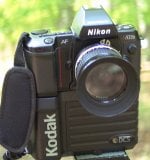
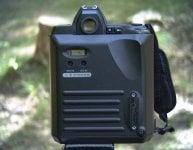
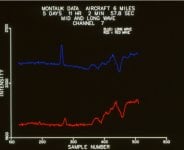
Before that- we made our own. I found a slide made from the "Dicomed" computer camera, circa 1982. We built a two-color (Mid and Long wave) IR sensor, digital- stored to 7-track computer tape. I wrote all the software for processing and image display. Hard to believe this was 40 years ago. All in Fortran-66. That ran on an $8M Supercomputer.



Before that- we made our own. I found a slide made from the "Dicomed" computer camera, circa 1982. We built a two-color (Mid and Long wave) IR sensor, digital- stored to 7-track computer tape. I wrote all the software for processing and image display. Hard to believe this was 40 years ago. All in Fortran-66. That ran on an $8M Supercomputer.
Last edited:
Ko.Fe.
Lenses 35/21 Gears 46/20
Meh, typical internet, gearheads wisdom. *Last DSLR*.
Meanwhile I see more dslrs in real life than mirrorless. And it is with young ones.
KF is tempting due to my initials, but I will try to get one of the crop single K models. It is cheapest true weather sealed kit available on used market.
Meanwhile I see more dslrs in real life than mirrorless. And it is with young ones.
KF is tempting due to my initials, but I will try to get one of the crop single K models. It is cheapest true weather sealed kit available on used market.
Dogman
Mentor
Meanwhile there is an abundance of used DSLRs that continue to work perfectly just with fewer features. Having fewer features is a feature to some of us.
agentlossing
Well-known
Maybe no one else is using the few-years-old Pentax K-1 Mark II but me, but, let me say that it is a really excellent FF DSLR and I just don't see Ricoh/Pentax making an about face from that and the recent flagship APS-C K3 Mark III so quickly.
The DSLR market is way down from a few years ago, and not long ago Pentax held a small ~5% of that market. Maybe they figure with Nikon and Canon putting more resources into MILC line-ups, those that want to stick with a DSLR will look at them. The main problem with switching mounts is the investment in lenses. I'm happy with my Nikon Df for a DSLR, and very happy with the Z5. Also happy with the Leica M9. In a few years, I suspect a MILC will satisfy both requirements as it can use all of my lenses.
If Pentax picks up market share- they could afford the NRE for coming out with a new digital camera. But at the present sales levels, hard to see how they could cover the NRE of developing a major new DSLR.
If Pentax picks up market share- they could afford the NRE for coming out with a new digital camera. But at the present sales levels, hard to see how they could cover the NRE of developing a major new DSLR.
Cascadilla
Well-known
I've been a happy Pentax DSLR user since 2004 and really like my K-1. Would I buy K-1 mark 3 with a larger megapixel chip and a faster write to card speed? I would certainly be tempted since I already own a great set of macro lenses (3 Pentax, a Sigma 70 and an Irix 150) which could handle more megapixels if they were available. I realize that isn't that helpful to Pentax since they would like to sell me more lenses as well...
I wouldn't be surprised if Pentax carves out a little nitch for itself eventually as the last remaining maker of 35mm pattern dSLR cameras. And I have favored Pentax since the early 1960s before the Spotmatic. Here too a current user of the K1 upgraded to MkII, and an original K3 not to mention a dozen or so film Pentaxes plus half a dozen medium format. Do you think Leica will continue to produce the S model dSLRs?
pvdhaar
Peter
Leica was sort of the last man standing in a contracting market when it comes to rangefinders and they're still around. Wouldn't surprise me if Pentax could pull off a similar trick.
Pál_K
Cameras. I has it.
Count me in as someone who would be part of that niche group. I love Pentax and their cameras.I wouldn't be surprised if Pentax carves out a little nitch for itself eventually as the last remaining maker of 35mm pattern dSLR cameras. And I have favored Pentax since the early 1960s before the Spotmatic. Here too a current user of the K1 upgraded to MkII…
Right now I’d love to have a K-1. When the Mk II came out I read dpreview and went in circles trying to decide whether I’d prefer the Mk I or Mk II - I still don’t know.
What are your thoughts and likes/dislikes having upgraded?
agentlossing
Well-known
Doug will no doubt be able to speak to it better than I, since I haven't owned the Mk I, but from what I understand the difference is rather small, unless you are shooting at certain (high) ISOs, or focusing with specific lenses maybe. Personally I'd put it down to the deal you can get, but there's no sense in continuing to miss out due to analysis paralysis!Count me in as someone who would be part of that niche group. I love Pentax and their cameras.
Right now I’d love to have a K-1. When the Mk II came out I read dpreview and went in circles trying to decide whether I’d prefer the Mk I or Mk II - I still don’t know.
What are your thoughts and likes/dislikes having upgraded?
If you have access to purchasing used from Lensrentals, I think they have a good deal right now on the Mk II.
Cascadilla
Well-known
I have a Mark 1 and bought it instead of a Mark 2 since the changes were small and not important to me. I have been very happy with the results.
Keith
The best camera is one that still works!
The last DSLR in my world has been the Nikon D4 that I bought used many moons ago ... big and ugly yes but still has a nice sensor by any standard. My next camera will probably be a Sony Alpha ... used of course! 
Well, in doing the upgrade to K1 Mk II, I believe my thinking at the time was "later is better" and some amazement that such an operation was even offered, and that I should take advantage of it. I thought also it was a bit pricey to get the work done, and I probably haven't made good use of the improvements. I'm a pretty basic user... for instance the only time the articulating rear screen has been folded out was when the camera slipped off my shoulder and I caught it by the strap on the way down and it jerked to a stop, unfolding the screen!
Pál_K
Cameras. I has it.
Does the Pentax K-1 Mk I have illuminated buttons like the Mk II?
Yokosuka_Mike
Abstract Clarity
I had the Sigma SD1 Merrill DSLR camera and I thought I had died and gone to heaven. The images that camera could produce were so satisfying! Well, I hadn't died and no heaven either. It was a fantastic camera and I enjoyed it very much but eventually it just couldn't keep up with the kind of photography I wanted to do. I sold it.
I look at the Pentax DSLRs and I get that same old feeling I had with the Sigma SD1. I want one, I need one, can I afford one? DSLRs look so cool... I said the same thing about the Fujifilm X-Pro2 (and I bought one of them).
Where does it all end? Answer - it doesn't!
All the best,
Mike
I look at the Pentax DSLRs and I get that same old feeling I had with the Sigma SD1. I want one, I need one, can I afford one? DSLRs look so cool... I said the same thing about the Fujifilm X-Pro2 (and I bought one of them).
Where does it all end? Answer - it doesn't!
All the best,
Mike
Keith
The best camera is one that still works!
I still have my SD1M and my DP2 and DP3 Merrills.I had the Sigma SD1 Merrill DSLR camera and I thought I had died and gone to heaven. The images that camera could produce were so satisfying! Well, I hadn't died and no heaven either. It was a fantastic camera and I enjoyed it very much but eventually it just couldn't keep up with the kind of photography I wanted to do. I sold it.
I look at the Pentax DSLRs and I get that same old feeling I had with the Sigma SD1. I want one, I need one, can I afford one? DSLRs look so cool... I said the same thing about the Fujifilm X-Pro2 (and I bought one of them).
Where does it all end? Answer - it doesn't!
All the best,
Mike
Yokosuka_Mike
Abstract Clarity
I still have my SD1M and my DP2 and DP3 Merrills.
The images those cameras produce are unmatchable! (is unmatchable a word?) Anyway, the best images I ever made were with Sigma cameras - the SdQH is a legend in my book!. Unfortunately those Sigma cameras couldn't fly with the eagles when it came to fast AF or high ISO. If I was wealthy and had a lot of room in my house I'd still have those Sigma cameras.
Mike
Share:
-
This site uses cookies to help personalise content, tailor your experience and to keep you logged in if you register.
By continuing to use this site, you are consenting to our use of cookies.

